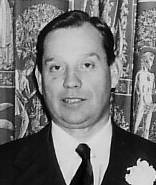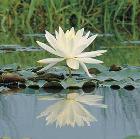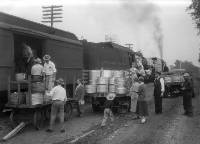|
Charles B. Thomas All images provided by and © 2004, 2006 Charles B. Thomas Preface by Kit Knotts |

|
|
The Early Years
I've been in love with waterlilies and water gardening ever since
I can remember. A cousin pulled me, a pre-kindergartener in 1939,
out of my maternal grandmother's oval concrete water garden.
I had gingerly walked across a flimsy board to sample the sweet
fragrance of a Nymphaea 'Mrs. C. W. Thomas' that honored
my father's paternal grandmother. The board and I began to shake.
I promptly lost balance and unwillingly dived into the pond.
Undaunted, my fondness continues today.

Dr. G. L. Thomas Jr., 1953 Read the charming excerpt from Dr. Thomas' book describing the history of Three Springs Fisheries - Lilypons |
Perhaps this love affair originated in my genes. Grandfather G. Leicester Thomas was so fascinated with waterlilies that when he began Three Springs Fisheries (a goldfish hatchery) in 1917, he included them and other water garden plants as a sideline. My father, Dr. G. L. Thomas, Jr., used them effectively when courting my mother, Virginia Louise. As spring turned into summer in 1936, Miss Lily Pons helped to dedicate the newly established U. S. Post Office at Lilypons, Maryland. An internationally acclaimed featured singer of the New York Metropolitan Opera, she also starred in Hollywood films like I Dream too Much with Henry Fonda. Jerome Kern wrote music especially for the film. Maryland's governor along with Frederick City, Frederick County, and state officials attended. The Maryland National Guard Band of Baltimore performed for the crowd of thousands. |
|
 My
personal memento of this event is a picture of Lily Pons holding
nine-month-old Charles Thomas in her arms. Other photographs
include Miss Lily Pons in a canoe on a lily pond at Lilypons,
and her standing in the Lilypons post office doorway with an
uncle. The New York Times and other major newspapers covered
the event with photos and long articles. Goings-on were broadcast
live on the radio.
My
personal memento of this event is a picture of Lily Pons holding
nine-month-old Charles Thomas in her arms. Other photographs
include Miss Lily Pons in a canoe on a lily pond at Lilypons,
and her standing in the Lilypons post office doorway with an
uncle. The New York Times and other major newspapers covered
the event with photos and long articles. Goings-on were broadcast
live on the radio.In 1942 we moved from our mountaintop home in Braddock Heights, Maryland, to Clifton on the Monocacy (native American for River of Many Bends), our family farm on Buckeystown Pike. Daughter Virginia Crum and her family have been residing there since 2002. I began taking piano lessons when in the second grade, and tap and ballroom lessons while in the sixth grade. It was at the Evelyn R. White Studio of the Dance that I noticed a very special ballet student, Sally Smith. She later became the mother of our four daughters. Charlie Winch named a waterlily after her following his stay at our home in the mid-1980s.
At Elm Street Junior High School and Frederick High School I was a member of the school newspaper staff. As a cub reporter I promptly learned that accuracy in news reporting is paramount. In high school I switched to the business side and became advertising and business manager for three years. This position gave me valuable experience selling advertising space to diverse businesses, billing clients, collecting payments for invoices, and satisfying advertisers.
I also learned about running campaigns for student council, class officer, and executive council. I won elections of each type, and lost some, too. But I did gain a lot of knowledge about peer relationships, committees, and parliamentary rules. As so often happens, early-life experiences help in navigating the waters of life. Youthful experiences can greatly influence future accomplishments. I definitely found this to be true for me.
Following World War II, Americans could indulge in construction not hampered by wartime restrictions. A dream came true when our family built a concrete lily pond at home. At that site Charles Tricker pointed out the effects of cold well water upon a tropical, N. 'Missouri' in this case. Its blooming diminished as it produced lots of arrowhead shaped leaves. It produced a beautiful tuber.
Although earlier I had created and enjoyed a tub garden featuring N. 'Chrometella', submerged and shallow water plants, two small goldfish and two black Japanese snails, it was a traditional pond that I so desired. As a youngster, I always enjoyed seeing and smelling both hardy and tropical lilies, and lotuses, too. I was very excited that I could enjoy these aquatic beauties in our new pond at home.
With gasoline and other rationing a thing of the past, our family could travel-to Binghamton, New York, to see Perry Slocum, HF (HF indicates an IWGS Hall of Fame member), and Slocum Water Gardens; to Saddle River, New Jersey, to see Charles Tricker and Tricker's; to Martinsville, Indiana, to see Stanley Byram and Grassyfork Fisheries (which, like Three Springs, mailed an annual water gardening catalog nationally) to Stoutland, Missouri, to see Lawrence Balliaire and Ozark Fisheries, and many other places. Grassyfork, Ozark, and Three Springs each claimed to be the largest of its kind in the world, but I never heard the principals argue the matter when they were face to face.
It was at such meetings that I realized how wonderful it would be if others could meet with professional aquatic nurserymen to exchange ideas. I learned that visits to various places with knowledgeable people are very exciting and rewarding. These meetings planted a seed that would emerge as The Water Lily Society in 1984.
An especially memorable trip occurred in 1950 when I visited Miami, Florida, Mexico City, Acapulco, Merida (Yucatan), Mexico, and Havana, Cuba. Later, while attending the University of Maryland, brother George, III, and I represented our college fraternity (where as treasurer I kept the books, paid the bills and insisted on dues payments from sometimes cash-short brothers) at its annual convention held in Houston. While there, we visited Houston's water garden guru, Carl E (Charlie) Fischer. He grew a beautiful hybrid of his own, N. 'Pride of Houston', that he sold to admirers.
Also while in college I rode the California Zephyr to California, and continued by rail to Seattle, Buchard Gardens in Victoria, British Columbia, Canada, and by train back to Chicago from where we drove home. Everywhere I was looking for waterlilies and other ornamental aquatics.
In another exciting trip in the early 50s, I flew with Baltimore Sun award-winning photographer/author A. Audrey Bodine to meet George H. Pring, HF, for a personally conducted Missouri Botanical Garden tour with liberty to photograph as we pleased. This significantly helped to fulfill my father's desire to ensure accuracy in aquatic plant identification and in aquatic plant photography for Three Springs Fisheries literature and for the water garden book he was writing.
Importing waterlilies from the late Joseph Bory Latour-Marliac's, HF, nursery establishment in Temple sur Lot, France, provided both suspenseful delight and unexpected disappointment. Dad wanted to introduce cultivars he couldn't find in North America. To our disappointment we slowly discovered that not all of the plants were properly labeled. This demonstrated to me as a beginner the serious need for internationally recognized identification and attention to proper labeling.
At the University of Maryland in College Park, I decided to major in marketing. I figured on working at Lilypons Water Gardens following graduation. So it seemed that by knowing as much as possible about marketing, I could sell more people on the idea of enjoying a water garden.
I started working there at age 15. It seemed to me that if people only knew water lilies as I knew them, they would sell themselves. In addition, the idea of earning money by selling things fascinated me.
When I became old enough, perhaps 10 years old, to ride a two-wheel bicycle alone on the road, and to carry on it crab apples or honey produced on the farm, I sold them door-to-door in Buckeystown. Many of the residents retired there from a life of working on nearby farms. Both as a teen and later as a marketing major, I learned what it takes to have people purchase what you produce.
My favorite work at Lilypons, however, was working with the
waterlilies and other water garden plants. This included propagation,
growing, harvesting, packing, shipping, and selling. I sold to
walk-in customers, phone customers, and corresponding customers.
I quickly realized that I could learn from customer experiences
in addition to what I learned professionally.
In the 1950's before credit cards and 800-toll-free phone numbers,
a few catalog customers would call on the telephone to place
orders to be shipped. Individuals who called and wanted their
retail order shipped received instant credit. Non-payment losses
were virtually non-existent. I found that people who grew waterlilies
were extremely honest in their dealings. And the company readily
replaced or refunded payment to those very few whose expectations
were not meet.
A steady flow of goldfish and waterlily people from around the
country and abroad visited Lilypons. Often Dad would bring them
home for a meal, or even an overnight stay. Although many experts
paid visits, enthusiasts also came. A young Thai graduate student,
Slearmlarp "Sam" Wasuwat, HF, studying forestry at
the University of Wisconsin made a special impression on Dad.
He eventually rose to the top of Thailand's government ministry
overseeing that nation's rubber tree industry. During a visit
Dr. Sam made to Lilypons, Dad gave him a copy of Dad's book,
writing "For his Excellency, Slearmlarp Wasuwat, Ph.D. With
best wishes. G. L. Thomas, Jr. 1971 Sept. 28."
Copyright 2004 Charles B. Thomas
Page 1 | Page 2 | Page 3 | Page 4 | Page 5
"Visit to Lilypons" by Dr. G. L. Thomas, Jr.

